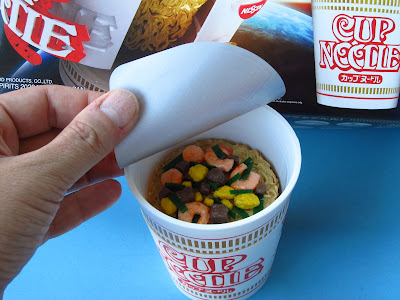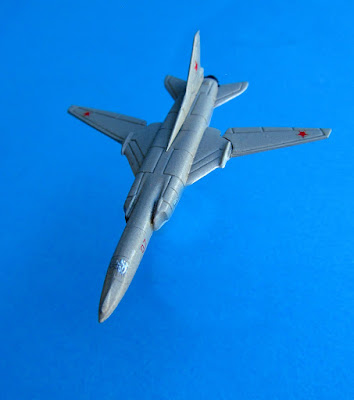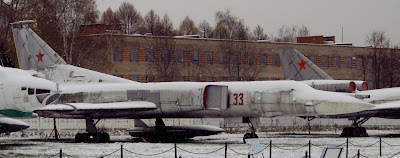HAPPY ANNIVERSARY! This is the very unusual 1:1 scale plastic model from BanDai of the famous CUP NOODLE カップヌードル Kappu Nūdoru original product from Nissin of Japan in celebration of the 50th anniversary of the premiere of the instant ramen cup noodle on this day, 18 September 1971.
The model was released in celebration of the impending 50th anniversary of Cup Noodle 発売50周年を記念するCM. Instant ramen noodles were invented by Momofuku Ando in 1958, and the three-minute Cup Noodles premiered on 18 September 1971. Sales of Cup Noodles begin at Isetan Department Store in Tokyo's Shinjuku district. If you happen to be in Yokohama or Osaka Japan feel free to visit either or both of the Cup Noodle Museums (https://www.cupnoodles-museum.jp/ja/) for the full unadulterated cup noodle experience, and to buy cup noodle merchandise if what you need is cup noodle merchandise.
The kit is without doubt some of the best engineering of plastic model parts I have ever seen. Several of the ring parts are moulded with the sprue on the inside of the ring so that removal does not leave any visible signs on the outside of the parts. Amazing! The whole thing is a snap-together model, and the tolerances and fit are superb. Who needs glue?
Nissin writes about the model: "Make without eating. Cup noodles become plastic models! ?? Bandai brings together the technology to faithfully reproduce every detail. "1/1 cup noodle plastic model" that can not be made in 3 minutes is born!" Further it was noted "Capturing the unmistakable styrofoam packaging of Cup Noodles, the 1:1 model was created from a 3D scan of an on the shelf offering to accurately represent the cup, noodles and flavoring accouterments."
The most amazing aspect of the kit is the plastic wrap stickers for the shrimp parts. The shrimp are moulded in an orange plastic which does not look much like cooked shrimp. The plastic sticker fits almost perfectly on a bumpy compound curved surface and instantly gives the proper colour for shrimp. It is hard to believe just how well thought out is this kit. The food parts are astoundingly life like, if you consider instant ramen to be food. DO NOT EAT THIS - IT IS A MODEL! The glossy wet-like surface of the food parts was done using Future floor wax.
In celebration of Cup Noodle I have purchased three flats of chicken (flavoured) Cup Noodle. Sadly these are not the Japanese original, but only a US made licensed product. It is very tough to get Cup Noodle in Canada, Mine came from Staples business supply store. Photos of the model with the real thing appear below. The model looks good enough to eat. DO NOT EAT THIS - IT IS A MODEL!
 |
| BanDai's 50th anniversary 1:1 scale model of Nissin's CUP NOODLE |
 |
BanDai's 50th anniversary 1:1 scale model of Nissin's CUP NOODLE
|
 |
BanDai's 50th anniversary 1:1 scale model of Nissin's CUP NOODLE
|
 |
| BanDai's 50th anniversary 1:1 scale model of Nissin's CUP NOODLE |
 |
BanDai's 50th anniversary 1:1 scale model of Nissin's CUP NOODLE.
Real (US made) chicken Cup Noodle (left) beside the model (right). |
 |
BanDai's 50th anniversary 1:1 scale model of Nissin's CUP NOODLE.
The noodle pack, with egg bits, shrimp bits, leeks, and "mystery meat" bits,
coated with Future floor wax. |
 |
BanDai's 50th anniversary 1:1 scale model of Nissin's CUP NOODLE.
The ten part noodle pack. |
 |
BanDai's 50th anniversary 1:1 scale model of Nissin's CUP NOODLE.
Sprue |
 |
BanDai's 50th anniversary 1:1 scale model of Nissin's CUP NOODLE.
Lettering for the cup and sprue |
 |
| BanDai's 50th anniversary 1:1 scale model of Nissin's CUP NOODLE |
 |
BanDai's 50th anniversary 1:1 scale model of Nissin's CUP NOODLE.
Cup with a trap door for looking at the noodle pack. |
 |
| BanDai's 50th anniversary 1:1 scale model of Nissin's CUP NOODLE |
 |
shrimp decals for BanDai's 50th anniversary 1:1 scale model of Nissin's CUP NOODLE
|
 |
shrimp with decals applied on BanDai's 50th anniversary 1:1 scale model of Nissin's CUP NOODLE
|











